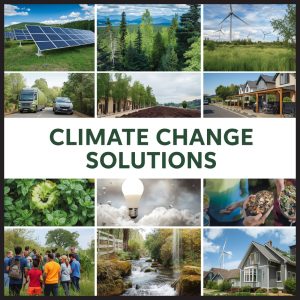Table of Contents
ToggleClimate Change Solutions
Climate Change Solutions are no longer just a scientific discussion—they’re a global necessity for the survival of humanity and the planet. As rising temperatures, melting ice caps, and extreme weather events continue to intensify, the need for immediate and practical Climate Change Solutions becomes increasingly urgent. Governments, industries, and individuals all have a role to play in reducing greenhouse gas emissions, protecting ecosystems, and shifting toward renewable energy. The battle against climate change is not just about avoiding disaster—it’s about creating a cleaner, more resilient, and sustainable world for future generations.

Understanding the Root Causes of Climate Change
Before exploring Climate Change Solutions, it’s crucial to understand what drives this global crisis. The primary cause is the excessive release of greenhouse gases like carbon dioxide, methane, and nitrous oxide, which trap heat in the Earth’s atmosphere. The burning of fossil fuels for energy, deforestation, and industrial agriculture are the leading contributors.
A shift toward renewable energy sources such as solar, wind, and hydroelectric power is one of the most effective ways to mitigate these emissions. Moving away from coal and oil not only reduces carbon pollution but also promotes energy independence. Governments must support clean energy initiatives that make renewables affordable and accessible to all communities.
Moreover, addressing deforestation and land degradation is equally important. Forests act as carbon sinks, absorbing CO₂ and maintaining ecological balance. When trees are cut down for agriculture or urban development, that balance is destroyed. Encouraging reforestation and sustainable forestry can restore natural ecosystems and strengthen our defense against global warming.
Renewable Energy: Powering a Greener Tomorrow
Transitioning to renewable energy systems is at the heart of effective Climate Change Solutions. The use of wind turbines, solar panels, and geothermal energy dramatically reduces reliance on fossil fuels. Countries that invest in renewables not only cut emissions but also stimulate job creation and technological innovation.
For example, solar power advancements have made it possible for homeowners to generate their own electricity and even sell excess energy back to the grid. Similarly, wind energy has become one of the cheapest and cleanest sources of power available today. The adoption of sustainable power infrastructure ensures energy security and environmental protection simultaneously.

A critical component of renewable expansion is improving energy storage technology. Batteries that can store solar and wind energy for extended periods help balance supply and demand, making renewable systems more reliable. As these technologies evolve, they become increasingly viable replacements for fossil-based grids.
Additionally, energy-efficient buildings play a vital role. By using smart designs, natural lighting, and efficient insulation, energy consumption can be reduced dramatically. The construction industry’s move toward eco-friendly materials further supports this effort, showcasing how innovation can complement sustainability.
Transportation and Sustainable Mobility
One of the most challenging sectors to decarbonize is transportation, but it’s also one of the most promising areas for Climate Change Solutions. Cars, trucks, and airplanes are major emitters of CO₂. However, electric vehicles (EVs) are transforming the landscape.
The global adoption of electric mobility systems is increasing rapidly as battery technology improves and charging infrastructure expands. Governments offering incentives for EV purchases and installing public charging stations are paving the way for greener cities. These efforts not only reduce emissions but also decrease urban air pollution, improving public health.
Public transport innovations also serve as an essential part of sustainable urban planning. Expanding bus routes, promoting cycling, and building pedestrian-friendly streets help reduce dependence on private vehicles. Implementing mass transit modernization ensures that mobility is efficient, inclusive, and environmentally responsible.
The aviation and shipping industries are exploring biofuel alternatives to minimize their carbon footprints. While still developing, these fuels show great promise for long-term sustainability. As countries commit to net-zero transportation goals, collaboration between policymakers, manufacturers, and consumers becomes key.
Agriculture and Food Systems for a Sustainable Planet
The agricultural sector is both a contributor to and a potential solution for climate change. Industrial farming releases massive amounts of greenhouse gases through fertilizer use, livestock emissions, and soil degradation. To build sustainable Climate Change Solutions, agriculture must evolve into a more eco-conscious practice.
Implementing regenerative farming techniques—like crop rotation, cover cropping, and reduced tillage—helps restore soil health and capture carbon from the atmosphere. Farmers adopting organic cultivation methods avoid harmful pesticides and chemicals, protecting biodiversity. These approaches not only sustain the environment but also improve food security and resilience against climate shocks.
Furthermore, reducing food waste management problems is essential. A significant percentage of produced food never reaches consumers, resulting in wasted resources and methane emissions from landfills. Encouraging responsible consumption, recycling organic waste into compost, and supporting sustainable food systems can drastically reduce emissions.
The promotion of plant-based diets also contributes to emission reduction. Livestock farming is one of the largest sources of methane, and even a small global shift toward plant-based nutrition could significantly lower greenhouse gases. Supporting climate-smart agriculture ensures that food production meets the needs of a growing population without exhausting the planet’s natural systems.
Industrial and Corporate Responsibility
Industrial emissions represent a major share of the climate problem, but they also hold the potential for meaningful Climate Change Solutions. Companies around the world are being held accountable for their environmental impacts, leading to a surge in corporate sustainability initiatives.
Adopting green manufacturing practices involves reducing waste, using renewable energy in production, and developing circular supply chains. Many forward-thinking companies are designing products with recycled and biodegradable materials, ensuring that the end-of-life phase of a product has minimal environmental damage.
Additionally, carbon offset programs are becoming a core part of corporate strategies. These initiatives allow companies to compensate for their emissions by funding projects like tree planting, renewable energy farms, or methane capture systems. Though offsetting alone isn’t enough, it plays a crucial role in a broader strategy of emission reduction.
Investment in clean technology research continues to drive innovation in sustainability. From advanced recycling systems to energy-efficient data centers, industries are finding ways to merge economic growth with ecological preservation. By aligning profitability with responsibility, corporations can lead the fight against climate change.
The Role of Policy and Global Cooperation
Effective Climate Change Solutions require strong policy frameworks and international cooperation. The Paris Agreement stands as a landmark global commitment to limit temperature rise to well below 2°C above pre-industrial levels. However, real progress depends on enforcement and accountability.
Governments must introduce carbon pricing systems that make polluters financially responsible for their emissions. These policies incentivize industries to invest in cleaner technologies. Additionally, renewable energy subsidies help accelerate the transition to green power by making sustainable options more affordable for consumers.

Developed countries also have a moral responsibility to support climate adaptation programs in developing nations. These regions often face the harshest impacts of climate change despite contributing the least to the problem. Investments in climate-resilient infrastructure, early warning systems, and sustainable water management can prevent humanitarian crises.
Global collaboration through climate finance mechanisms ensures that no country is left behind in the journey toward sustainability. Multinational partnerships, cross-border research, and data-sharing initiatives strengthen the collective effort against climate change.
Individual Actions That Create Global Impact
While large-scale changes are crucial, individuals play an equally vital role in advancing Climate Change Solutions. Small, consistent actions—like conserving energy, recycling, or supporting eco-friendly products—can have a massive cumulative effect.
Switching to energy-efficient appliances, reducing single-use plastics, and opting for sustainable transportation options like cycling or public transit are all impactful steps. Supporting brands that prioritize sustainability and holding governments accountable for climate action amplifies the collective voice for change.
Individuals can also engage in community climate initiatives—from local tree-planting projects to clean-up drives—that build awareness and foster responsibility. Educating younger generations about climate science ensures that environmental stewardship becomes an intergenerational commitment.
The digital era offers powerful platforms for advocacy. Social media campaigns promoting environmental awareness can mobilize millions and influence policy. Every act of environmental responsibility, no matter how small, contributes to a global ripple effect of change.
Future Technologies and Innovation
The next frontier in Climate Change Solutions lies in innovation. Emerging technologies such as carbon capture and storage, direct air capture, and bioenergy with carbon sequestration are designed to remove carbon from the atmosphere. These methods complement emission reduction efforts by addressing existing pollution.
Artificial intelligence and data analytics are also playing transformative roles. Predictive climate models, AI-powered energy management, and smart agriculture systems enable efficiency and precision. By integrating technology with sustainability, humanity can create a balance between progress and preservation.
Meanwhile, green hydrogen—a clean fuel produced using renewable energy—is expected to revolutionize heavy industries like steel and shipping. As investments in these technologies grow, they bring us closer to achieving net-zero emissions.
Innovation isn’t limited to technology alone. It extends to education, governance, and finance, where climate-conscious investment strategies are reshaping markets. Green bonds and sustainable funds are channeling trillions of dollars toward projects that prioritize the planet’s well-being.
Conclusion
In conclusion, Climate Change Solutions represent the intersection of science, policy, innovation, and human will. Every sector, from energy to agriculture, has a role in addressing this global crisis. By embracing renewable energy, sustainable agriculture, green technology, and responsible consumption, humanity can reverse the damage already done.

The journey toward a stable climate is challenging, but it’s also an opportunity to rebuild a better world—one defined by cooperation, equality, and sustainability. The choices made today will shape the lives of future generations. Every action, from planting a tree to inventing cleaner technologies, contributes to a collective mission of hope and renewal.
The time to act is now. Climate Change Solutions are within our reach, and together, humanity holds the power to heal the planet, restore balance, and secure a thriving future for all living beings.
